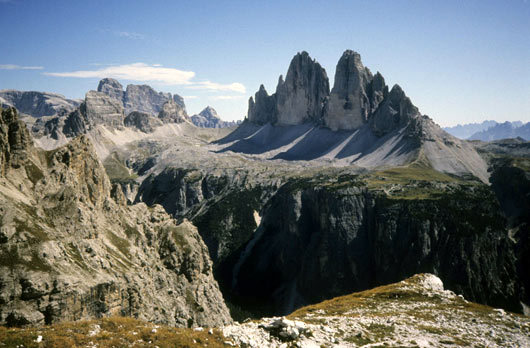
Seen from the northwest, the Tre Cime di Lavarado lie in the northeast (Sextener) region of the Italian Dolomites and are one of this area’s most iconic features. There are actually five towers in total, from left to right: Cima Piccolissima (2700m); Punta di Frida (2792m); Cima Piccola (2857m); Cima Grande (2999m); Cima Ovest (2973m). The new Huber route, Pan Aroma (5.14b, 500m, final ascent Hinterbrander-Huber-Reichel, 2007) lies toward the right side of the north face of the Ovest. [Photo] Claudio Cima
Although the amount of independent climbing is relatively small in proportion to the length of the route, Alex Huber’s variation on the north face of the Cima Ovest (2973m) in the Tre Cime di Lavarado is a major addition to the evolution of Dolomite free climbing. Pan Aroma has a crux of 5.14b, putting it in league with the hardest big wall free routes in the world.
The right side of the 500-meter high north face is characterized by a huge stepped roof at about one-third height. The challenge of this obstacle was taken up in 1968 during the “direttissima” era by Gerhard Bauer, Erich and Walter Rudolph, who systematically placed pitons and drilled a line of bolts across the great roof at its widest point, reaching the Kasperek Bivouac after 200 meters and finishing up the classic Cassin Route (5.11b all free, 450m, Cassin-Ratti, 1935).
In 1994 Huber made an ascent of the Swiss Route to the left (5.8 A3 but all free at 5.12c by Kurt Albert in 1987, 500m, Scheibert-Weber, 1959). Looking right he saw the great roof of the Bauer-Rudolph and envisaged that one day it might provide one of the most outstanding and spectacular free climbs in the world.
He was right but didn’t test the rock in this area for six years. In the winter of 2000 Huber put up Bellevista between the Swiss Route and the Bauer-Rudolph, climbing the first four pitches free up to 5.12c and then breaking through the roof by a series of leftward traverses in four more pitches (A2+, A4, A4 and A3). A final pitch of 12a led to the junction with the Swiss Route two pitches before it joins the Cassin at the Kasperek Bivouac. Huber returned in 2001 and worked on the route during the summer, placing protection points and finally redpointing the line with Gernot Flemisch. The sixth and seventh pitches were strung together to create a 55-meter runout pitch of 5.14b, the first time that this standard of difficulty had been climbed high on a big alpine face.
In June this year Huber began investigating a line through the roof based around the Bauer-Rudolph. He followed the first five pitches of Bellavista but then broke across the roof to the right, weaving a line around the Bauer-Rudolph before eventually making the redpoint on July 26 with Franz Hinterbrander and Max Reichel.
On their final ascent the three bivouacked at the usual spot above the roof and the next day reached the summit via the Cassin. The sixth pitch is a full 60 meters long, protected by seven bolts and rated 5.14a, while the 20-meter eighth pitch provides the 14b crux. Two further pitches of 11b and 11c respectively lead to the Cassin. Although eleven new bolts were placed and no extra gear except quick draws is necessary, there are some long runouts in an outrageous position.